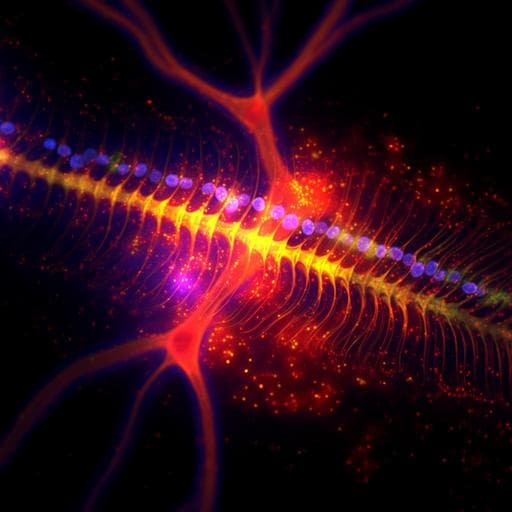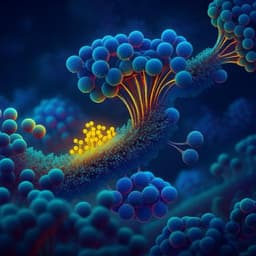
Biology
Fast and light-efficient remote focusing for volumetric voltage imaging
U. L. Böhm and B. Judkewitz
Discover a breakthrough in biomedical research with flipped image remote focusing (FLIRF), a novel method developed by Urs L. Böhm and Benjamin Judkewitz that enhances light efficiency, paving the way for 500 volumes per second in volumetric voltage imaging. This innovative technique captured the activity of over 100 neurons in a zebrafish spinal cord, revolutionizing the potential for high-speed imaging.
~3 min • Beginner • English
Introduction
Genetically encoded voltage indicators promise high-speed, parallel neural recordings, but typical frame rates required for voltage imaging (500–1000 Hz) restrict acquisition to a single focal plane, limiting access to inherently 3D neural tissues. Conventional axial scanning by moving the imaging objective via piezo actuators is constrained to tens of Hz by inertia. Remote focusing relocates the focusing element away from the primary objective and can be implemented either by introducing defocus with tunable elements in a Fourier plane or by focusing onto a remote image plane. The latter yields fast, aberration-free imaging over a substantial axial range but, when using small movable mirrors, typically requires a quarter-wave plate and polarizing beamsplitter to separate illumination and emission paths, losing over 50% of unpolarized fluorescence—particularly detrimental for sub-millisecond integrations in voltage imaging. Consequently, remote focusing has seen broader use in two-photon excitation paths rather than emission. To overcome these limits, the authors propose flipped image remote focusing (FLIRF), which maintains high-speed aberration-free refocusing while eliminating polarization optics by using a microscopic retroreflector that flips and folds the remote image. This allows spatial separation of incoming and refocused light with a knife-edge mirror, enabling high-speed volumetric voltage imaging with improved photon efficiency.
Literature Review
Prior light sheet voltage imaging has recorded tens of neurons but is typically limited to a single plane due to the need for rapid focusing. Axial motion of heavy objectives via piezo actuators is limited in speed. Remote focusing approaches either introduce defocus with tunable optics in a Fourier plane or refocus at a remote image plane; the latter can achieve fast, aberration-free imaging over larger axial ranges. Conventional remote focusing implementations for emission paths use polarization optics (quarter-wave plate and PBS) to separate paths, losing over half the fluorescence. Remote focusing has therefore been more common in two-photon systems and less in emission-side light-sheet detection. Alternative strategies such as random access scanning and multi-point confocal scanning extend 3D access but are constrained by point-scanning trade-offs (parallelism and volumetric access). A recent concept sacrifices field of view (FOV) to gain efficiency, though geometry can limit usable FOV depth.
Methodology
Optical design and remote focusing: FLIRF replaces polarization separation with a miniature retroreflector in the remote image plane that flips half the field and folds the image back, allowing spatial separation of incoming and refocused light using a knife-edge mirror. The detection used a 16× 0.8 NA water immersion primary objective. Remote focusing optics comprised a tube lens with effective focal length 124 mm to achieve an angular magnification M ≈ 1.29, close to the immersion index ratio n1/n2 ≈ 1.33 for aberration-free refocusing. The remote objective was an air objective, and the retroreflector was custom-built from two aluminum-coated right-angle prism mirrors carefully aligned on an acrylic substrate and bonded with UV-curable adhesive.
Optical performance characterization: Point spread functions (PSFs) were measured with 0.1 μm fluorescent beads across multiple z-positions to quantify lateral resolution and intensity preservation with defocus. The system achieved a maximal lateral resolution of 0.53 μm (theory: 0.34 μm) and maintained over 80% of peak intensity across ~100 μm defocus at the center of the field. Zemax simulations (OpticStudio 17.5) assessed diffraction-limited performance and supported experimental PSF characterization.
High-speed axial scanning: A linear voice coil motor translated the retroreflector along the optical axis, reaching up to 500 Hz drive frequency over a 150 μm axial range. The accessible x-extent was 358 μm (limited by retroreflector size), while the usable z-range depended on camera frame rate, creating a tradeoff between x-FOV and number of z-planes per volume. Due to inertial dynamics, the retroreflector path was slightly ellipsoidal, producing a reproducible ~6.5 μm z-shift between up- and down-strokes that was digitally corrected. Continuous motion during rolling-shutter acquisition caused opposite tilts of optical planes during up- versus down-strokes; both tilt and y-shifts were accounted for in analysis.
Biological preparation and imaging: Larval zebrafish (3–4 dpf) expressing a genetically encoded voltage indicator were prepared under approved animal protocols. Fish were stained with fluorophore, paralyzed, mounted in agarose, and in some experiments exposed to PTZ to enhance neural activity. Light sheet illumination at 532 nm generated a thin sheet (λ/4 width ~3.4 μm; Rayleigh length ~17 μm). Fluorescence was filtered to reject excitation light and imaged onto a high-speed sCMOS camera. Volumetric datasets of spontaneous activity were acquired at 500 frames/s, with volumes partitioned into up- and down-stroke plane sets.
Data processing: Timing jitter between DAQ frame triggers and the camera clock was detected and corrected by modeling additive baseline shifts per sensor row using reference frames. Single-plane time series were motion-corrected following Cai et al. Volumes were assembled by aligning average images per z, splitting planes in half and stitching with the best-matching halves to account for tilt and offsets. Automatic 3D segmentation used Cellpose with a custom model to obtain 3D ROIs. Fluorescence traces were extracted by adapting the Cai et al. method to 3D, estimating an initial spike train and background per ROI, and iteratively forming weighted pixel sums that emphasized signal-contributing pixels. Manual curation removed duplicates and artifacts.
Key Findings
- FLIRF doubles light efficiency relative to conventional beamsplitter-based remote focusing by eliminating polarization optics and using a miniature retroreflector to spatially separate incoming and refocused light.
- High-speed volumetric imaging at 500 volumes/s was achieved over a 150 μm axial range; x-extent of the accessible volume was 358 μm (limited by retroreflector size).
- Optical performance: maximal lateral resolution of 0.53 μm (theoretical diffraction limit 0.34 μm). Peak intensity remained >80% across ~100 μm defocus at the center of the FOV.
- Mechanical and acquisition characteristics: reproducible ~6.5 μm z-offset between up- and down-strokes due to ellipsoidal motion, corrected digitally; opposite plane tilts for up/down strokes due to rolling shutter and continuous motion were handled in processing.
- Biological demonstration: In zebrafish spinal cord, 20 s recordings at 500 fps across 2 × 2 planes yielded >200 segmented cell bodies with sustained, minimal signals detected from >100 neurons after curation. Signals included clear rhythmic membrane oscillations during fictive locomotion and isolated single spikes; similar performance was observed in hindbrain with larger FOV but fewer planes.
- Photostability over recording duration: baseline bleaching exhibited a decay constant τ ≈ 72 s, with minimal reduction in action potential SNR over a 20 s session.
Discussion
FLIRF enables fast, aberration-free remote focusing for camera-based light-sheet voltage imaging while recovering photons otherwise lost in polarization optics, effectively doubling light efficiency compared to beamsplitter-based designs. The approach trades half the field of view for higher efficiency—a favorable exchange at kHz-rate imaging where FOV is already constrained by camera readout. Unlike beamsplitter-based designs, FLIRF does not increase optical element count, though alignment of the knife-edge mirror and retroreflector in conjugate image planes is relatively sensitive. Demonstrations in zebrafish show simultaneous recordings from over a hundred neurons with spike and rhythmic signals, highlighting FLIRF’s potential for large-scale, high-speed volumetric voltage imaging.
System limitations and operating regimes are governed by camera frame rate and voice coil motor force/acceleration. In sparsely labeled samples, larger axial sweeps per frame can avoid overlap, shifting the limit to the motor’s acceleration and range; in densely labeled samples the limit shifts to camera speed to prevent axial projection overlap. In both scenarios, the maximum number of simultaneously recordable neurons is largely set by camera capture rate. Overall, FLIRF bridges a key gap for fast 3D voltage imaging by combining remote focusing speed with improved photon efficiency for emission detection paths.
Conclusion
The study introduces FLIRF, a flipped-image remote focusing strategy that removes polarization optics by employing a miniature retroreflector, thereby doubling light efficiency and enabling 500 Hz volumetric voltage imaging over ~150 μm axial ranges. The system achieves sub-micron lateral resolution with robust intensity across ~100 μm defocus and supports parallel neural recordings from over a hundred neurons in zebrafish spinal cord and hindbrain. By exchanging half the FOV for markedly improved photon efficiency, FLIRF advances camera-based 3D voltage imaging where photon budgets and frame rates are limiting.
Future directions include expanding usable FOV without sacrificing efficiency (e.g., optimized retroreflector geometry and relay optics), improving mechanical trajectories and synchronization to minimize tilt/offset without post-correction, increasing axial range and volume rates via faster cameras and higher-force actuators, and enhancing robustness to alignment to facilitate broader adoption.
Limitations
- Halved field of view is intrinsic to the flipped-image separation strategy and is the main practical tradeoff for increased efficiency.
- Alignment sensitivity: the knife-edge mirror and retroreflector, being in conjugate image planes, require precise alignment to maintain performance.
- Mechanical trajectory deviations (ellipsoidal motion) introduce a ~6.5 μm up/down z-shift and plane tilts due to rolling shutter during continuous motion; these require calibration and computational correction.
- Volume extent is limited by either camera frame rate (dense samples) or voice coil motor force/acceleration (sparse samples); x-extent limited by retroreflector size (~358 μm in this setup).
- Resolution did not reach the theoretical diffraction limit (measured 0.53 μm vs 0.34 μm theoretical).
- Timing jitter between DAQ triggers and camera clock necessitates correction to avoid baseline noise; bleaching occurs (τ ≈ 72 s), though impact on AP SNR over 20 s was minimal.
Related Publications
Explore these studies to deepen your understanding of the subject.







